Northern Research Policy Contributions to Canadian Arctic Sustainability
Abstract
1. Introduction
2. Background
2.1. Geographic Context
2.2. Organizational Context
2.2.1. Yukon
2.2.2. Northwest Territories
2.2.3. Nunavut
2.2.4. Nunavik
2.2.5. Nunatsiavut
2.2.6. Government of Canada
2.2.7. National Indigenous Organizations
2.3. Sustainability Context
3. Methodology
3.1. Sourcing Documents and Inclusion Criteria
3.2. Coding
Coding for Sustainability
3.3. Description of Documents
4. Results
4.1. Partnership as the Foundation for Research Relationships
“I encountered in my discussions a profound sense of disillusionment, and sometimes distrust, related to agreements with the Government of Canada … The term co-development of policies with Canada was looked upon with suspicion. My overall impression was that there was a longstanding disconnect between the aspirational intentions and commitments of Ministers, and the paternalistic, at times obstructionist, approach by the bureaucracy to the implementation of these ideas.”[119]
4.2. Indigenous Knowledge in Relation to Research
4.3. Research and Governance Capacity
4.4. Outcomes of Research
“For Inuit, knowledge can only be described as such if it is used to improve the lives of others. If one has knowledge but does not share it or use it for the common good, then it is seen to have no value. In this light, all research must result in direct application to improving the lives of the people who contributed to the knowledge development. This understanding is critical to the design of all research being carried out with Inuit populations, but should be essential in all research anywhere.”[106]
“Research provides much-needed capacity transfer between communities and researchers, opportunities for Indigenous peoples to address issues of local priority, and jobs that put food on the table for many families, and that can become pathways to educational and knowledge development opportunities and stable employment.”[136]
4.5. Informing Policies and Decisions
“The next step in the evolution of scientific practice in the Arctic is linking community-driven Arctic research priorities with national policy development to ensure scientific investments benefit communities and answer key questions facing the Arctic. I firmly believe that the foundation of effective decision-making is good information. In the Arctic, that means being committed to placing equal value on Indigenous knowledge and western science.”[119]
4.6. Communication and Engagement
“This is also a time when all of this information is shared and promoted across the community so that there is a collective awareness of the issues and the process being proposed and that by sharing the background information, every community member is then able to consider the topic through the lens of personal experiences and ideas. In this way, the process of research is shared beyond those who are selected informants. This is an approach which seeks to raise critical consciousness across the community and build critical mass through engagement around the issues. It also sets the stage for meaningful knowledge translations of the data results.”[106]
5. Discussion
5.1. Aligning Research with Northern Policy Objectives
5.2. Expectations for Engagement in and Conduct of Research
5.3. Supporting Sustainability Decision-Making
6. Conclusions
- Develop multiscale, inclusive research partnerships–Research partnerships can be improved at both the individual and organizational scales to focus on northern sustainability priorities. This involves being inclusive of northern leadership, recognizing northern conceptualizations of sustainability, and ensuring benefits for northerners. Better partnerships with individual researchers result in improved projects and initiatives; however, organizational-scale partnerships (e.g., Indigenous or territorial government to university) have the potential to influence research agendas and improve research across multiple projects. The value of multiscale research partnerships has been recognized for some time; however, they can require considerable investments in personnel and financial capacity by all or some of the partners. When accompanied by policy directives, these investments can be impactful.
- Ensure distributed benefits–To ensure that the benefits of sustainability research are distributed across the North, both larger partner organizations and individual researchers need to consider how they can contribute to local research capacity and where their research could have the most impact. Some communities may be overburdened with research, while others do not benefit because they are lacking capacity to attract and engage researchers. Ensuring that benefits reach underserved communities or organizations may require more time invested in building relationships and more financial support for local participation.
- Develop dynamic, tailored communications for different audiences–Policy documents can be an effective means to communicate an organization’s research interests; however, they need to be tailored to the appropriate audience. The messages must be clear, concise, and avoid jargon. While sustainability issues are often complex and persistent, local priorities may change regularly. This type of information needs to be updated regularly and can best be communicated through a website, as opposed to a static report. Developing communication materials and policy documents can require dedicated staff or external support.
- Expand on research guidance related to policy contributions–There are numerous documents already available that provide research guidance and several established ethical and permitting processes for research. Organizations considering creating their own research guidance are encouraged to consider how they can fill gaps in existing guidance documents and avoid duplication of existing advice. Useful additions would be organizational-specific advice on connecting research with policy priorities, including clear guidance on how, when, and who to approach at a specific organization. Articulating specific policy and research interests or priorities can also help to attract relevant research partners. This requires time and human resources on the part of the organization; however, it can minimize duplication and maximize effort in developing tailored guidance where needed.
- Create more inclusive and accountable processes–Organizations that have the resources to develop and communicate broad research policies can create more inclusive processes to ensure transparency and accountability in how they include and represent Indigenous and community voices. Northern voices have been included in both scientific and policy literature in the past; however, their interests are usually communicated through the lens of the authoring organization. Crediting all contributors, including direct quotes, articulating and respecting Indigenous values, and developing more creative approaches to communicating guidance or policy-relevant findings (e.g., artistic graphics, short, plain-language text with appropriate translation, videos, podcasts, etc.) can help to enhance inclusion and accountability. Supporting the inclusion of smaller organizations and community members in policy development will require dedicated funding for their time to contribute. It also requires openness and transparency in ensuring that the input of contributors is clearly communicated and attributed.
Supplementary Materials
Author Contributions
Funding
Data Availability Statement
Acknowledgments
Conflicts of Interest
Appendix A. Coding Framework
| Coding Topics | Parent Codes | Sub-Codes |
|---|---|---|
| Research concepts | Capacity building | Compliance capacity; Cultural competency; Funding stability; Governance capacity; Research capacity; Review capacity; Training |
| Communication and engagement | Authorship; Clear communication; Consultation-engagement; Language; Local hiring; Local knowledge; Methods of community engagement 1; Oral history; Plain language; Translation | |
| Context | Academic standards 1; Advance northern scholarship; Colonial history of research; Community ignored 1; Cross-cultural context; Increase/decrease in research; Interdisciplinary; Knowledge network; New research paradigm; Research agenda | |
| Definitions | Definition community; Definition data; Definition Indigenous knowledge; Definition north/Arctic 1 | |
| Ethical protocols | Informed consent; Local approval; Local protocol; Withdrawing from research 1 | |
| Indigenous knowledge (IK) | Documenting IK; Generational knowledge 1; Indigenous research methodologies; Indigenous worldviews; Integrating IK & science; Sacred knowledge; Traditions 1 | |
| Research outcomes | Impact of research; Research benefits; Sustainability 1 | |
| Partnership | Accountability; Building relationships; Co-developing 1; Community needs 1; Northern participation; Research agreement; Research network; Researcher needs 1; Respect; Understanding | |
| Place | Culture camp; Land claims; Mapping; Research burden; Traditional homelands-territories; Traditional place names | |
| Research lifecycle | Research process | |
| Research planning | Identify funding; Identify project priorities & goals; Preliminary engagement; Recruit project team | |
| Research design | Choose methodology; Create timeline; Develop research question; Identify resource requirements; Literature-information search; Write proposal; Proposal review | |
| Preparing for research | Acquire permits; Acquire research license; Ethical review process; Gain local context; Gain local permissions; Plan logistics | |
| Conducting research | Analyze data; Collect data & information; Compliance requirements; Recording information; Storing data; Validate results | |
| Communicating research | Community reporting; Publications; Reporting; Sharing data; Writing results | |
| Implementing research | Evaluation; informing policy-decision | |
| Research roles | Advisor-mentor; Boundary organization 1; Community; Coordinator; Elder; Funder; Guide; Legislator-regulator; Local researcher; Participant; Partner organization; Principal investigator; Researcher; Reviewer; Student; Support staff-organization; Team member; Translator; User-consumer; Videographer-photographer; Youth |
References
- Government of the Northwest Territories. Knowledge Agenda: Northern Research for Northern Priorities; Government of the Northwest Territories: Yellowknife, NT, Canada, 2017.
- Government of Yukon; Government of the Northwest Territories; Government of Nunavut. A Pan-Northern Approach to Science; Government of Yukon; Government of the Northwest Territories; Government of Nunavut: Whitehorse, YT, Canada; Yellowknife, NT, Canada; Iqaluit, NU, Canada, 2016.
- Government of Yukon. Science Strategy; Government of Yukon: Whitehorse, YT, Canada, 2016.
- Inuit Tapiriit Kanatami. National Inuit Strategy on Research; Inuit Tapiriit Kanatami: Ottawa, ON, Canada, 2018. [Google Scholar]
- Brunet, N.D.; Hickey, G.M.; Humphries, M.M. Local Participation and Partnership Development in Canada’s Arctic Research: Challenges and Opportunities in an Age of Empowerment and Self-Determination. Polar Rec. 2016, 52, 345–359. [Google Scholar] [CrossRef]
- Ogden, A.E.; Schmidt, M.; van Dijken, B.; Kinnear, L. Science in the Yukon: Advancing a Vision for Evidence-Based Decision Making. Arctic 2016, 69, 210–221. [Google Scholar] [CrossRef]
- Petrov, A.N.; BurnSilver, S.; Chapin, F.S.; Fondahl, G.; Graybill, J.; Keil, K.; Nilsson, A.E.; Riedlsperger, R.; Schweitzer, P. Arctic Sustainability Research: Toward a New Agenda. Polar Geogr. 2016, 39, 165–178. [Google Scholar] [CrossRef]
- Riedlsperger, R.; Goldhar, C.; Sheldon, T.; Bell, T. Meaning and means of “sustainability”: An example from the Inuit settlement region of Nunatsiavut, Northern Labrador. In Northern Sustainabilities: Understanding and Addressing Change in the Circumpolar world; Fondahl, G., Wilson, G.N., Eds.; Springer International: Cham, Switzerland, 2017; pp. 317–336. ISBN 9783319461502. [Google Scholar]
- Fondahl, G.; Wilson, G.N. Exploring sustainabilities in the circumpolar North. In Northern sustainabilities: Understanding and Addressing Change in the Circumpolar World; Fondahl, G., Wilson, G.N., Eds.; Springer International: Cham, Switzerland, 2017; pp. 1–12. ISBN 9783319461502. [Google Scholar]
- Gearheard, S.F.; Shirley, J. Challenges in Community-Research Relationships: Learning from Natural Science in Nunavut. Arctic 2007, 60, 62–74. [Google Scholar] [CrossRef]
- Tondu, J.M.E.; Balasubramaniam, A.M.; Chavarie, L.; Gantner, N.; Knopp, J.A.; Provencher, J.F.; Wong, P.B.Y.; Simmons, D. Working with Northern Communities to Build Collaborative Research Partnerships: Perspectives from Early Career Researchers. Arctic 2014, 67, 419–429. [Google Scholar] [CrossRef]
- Brunet, N.D.; Hickey, G.M.; Humphries, M.M. Understanding Community-Researcher Partnerships in the Natural Sciences: A Case Study from the Arctic. J. Rural Stud. 2014, 36, 247–261. [Google Scholar] [CrossRef]
- Wilson, K.J.; Bell, T.; Arreak, A.; Koonoo, B.; Angnatsiak, D.; Ljubicic, G.J. Changing the Role of Non-Indigenous Research Partners in Practice to Support Inuit Self-Determination in Research. Arct. Sci. 2020, 6, 127–153. [Google Scholar] [CrossRef]
- Carter, N.A.; Dawson, J.; Simonee, N.; Tagalik, S.; Ljubicic, G.J. Lessons Learned through Research Partnership and Capacity Enhancement in Inuit Nunangat. Arctic 2019, 72, 381–403. [Google Scholar] [CrossRef]
- England, J.H.; Dyke, A.S.; Henry, G.H.R. Canada’s Crisis in Arctic Science: The Urgent Need for an Arctic Science and Technology Policy; or, “Why Work in the Arctic? No One Lives There”. Arctic 1998, 51, 183–197. [Google Scholar] [CrossRef]
- Hik, D.S. A Northern Science Policy for Canada. In Proceedings of the 2030 North: A National Planning Conference, Ottawa, ON, Canada, 1–4 June 2009. Paper 4. [Google Scholar]
- Korsmo, F.L.; Graham, A. Research in the North American North: Action and Reaction. Arctic 2002, 55, 319–328. [Google Scholar] [CrossRef][Green Version]
- Morris, D.W.; Beaulieu, M.; Hamilton, S.; Hik, D.S.; Lemelin, R.H.; Moses, M.M.; Müller, D.K.; Smith, M.A.; Smol, J.P. The Lakehead Manifesto: Principles for Research and Development in the North. Arctic 2013, 66, iii–iv. [Google Scholar] [CrossRef][Green Version]
- Pigford, A.E.; Hickey, G.M.; Klerkx, L. Towards Innovation (Eco)Systems: Enhancing the Public Value of Scientific Research in the Canadian Arctic. In Arctic Yearbook; 2017; Arctic Portal: Akureyri, Iceland; pp. 1–28. [Google Scholar]
- Natural Sciences and Engineering Research Council of Canada; Social Sciences and Humanities Research Council of Canada. From Crisis to Opportunity: Rebuilding Canada’s Role in Northern Research; Natural Sciences and Engineering Research Council of Canada; Social Sciences and Humanities Research Council of Canada: Ottawa, ON, Canada, 2000. [Google Scholar]
- Castleden, H.E.; Morgan, V.S.; Lamb, C. “I Spent the First Year Drinking Tea”: Exploring Canadian University Researchers’ Perspectives on Community-Based Participatory Research Involving Indigenous Peoples. Can. Geogr. Géographe Can. 2012, 56, 160–179. [Google Scholar] [CrossRef]
- McGregor, D.; Bayha, W.; Simmons, D. “Our Responsibility to Keep the Land Alive”: Voices of Northern Indigenous Researchers. Pimatisiwin J. Aborig. Indig. Community Health 2010, 8, 101–124. [Google Scholar]
- Yukon Native Brotherhood. Together Today for Our Children Tomorrow: A Statement of Grievances and an Approach to Settlement by the Yukon Indian People; Council for Yukon Indians: Whitehorse, YT, Canada, 1973. [Google Scholar]
- Castleden, H.E.; Mulrennan, M.E.; Godlewska, A. Community-Based Participatory Research Involving Indigenous Peoples in Canadian Geography: Progress? An Editorial Introduction. Can. Geogr. Géographe Can. 2012, 56, 155–159. [Google Scholar] [CrossRef]
- Ford, J.D.; Couture, N.; Bell, T.; Clark, D.G. Climate Change and Canada’s North Coast: Research Trends, Progress, and Future Directions. Environ. Rev. 2017, 26, 82–92. [Google Scholar] [CrossRef]
- Martello, M.L. Global Change Science and the Arctic Citizen. Sci. Public Policy 2004, 31, 107–115. [Google Scholar] [CrossRef]
- Nunavut Tunngavik Inc. Annual Report on the State of Inuit Culture and Society 2011–2013; Nunavut Tunngavik Inc: Iqaluit, NU, Canada, 2013. [Google Scholar]
- Wong, C.; Ballegooyen, K.; Ignace, L.; Johnson, M.J.; Swanson, H. Towards Reconciliation: 10 Calls to Action to Natural Scientists Working in Canada. Facets 2020, 5, 769–783. [Google Scholar] [CrossRef]
- Association of Canadian Universities for Northern Studies. Research Excellence in Yukon: Increasing Capacity and Benefits to Yukoners in the Social Sciences, Humanities and Health Sciences; Association of Canadian Universities for Northern Studies: Ottawa, ON, Canada, 2017. [Google Scholar]
- Association of Canadian Universities for Northern Studies. Research Excellence in the Northwest Territories: Holistic, Relevant and Ethical Research in the Social Sciences, Humanities and Health Sciences; Association of Canadian Universities for Northern Studies: Ottawa, ON, Canada, 2018. [Google Scholar]
- Pedersen, C.; Otokiak, M.; Koonoo, I.; Milton, J.; Maktar, E.; Anaviapik, A.; Milton, M.; Porter, G.; Scott, A.; Newman, C.; et al. ScIQ: An Invitation and Recommendations to Combine Science and Inuit Qaujimajatuqangit for Meaningful Engagement of Inuit Communities in Research. Arct. Sci. 2020, 339, 1–14. [Google Scholar] [CrossRef]
- Mearns, R. Nunavut, Uqausivut, Piqqusivullu Najuqsittiarlavu (Caring for Our Land, Language and Culture): The Use of Land Camps in Inuit Knowledge Renewal and Research. Master’s Thesis, Carleton University, Ottawa, ON, Canada, 2017. [Google Scholar]
- Sudlovenick, E. A Serological Survey and Inuit Qaujimajatuqangit of Ringed Seals (Nattiit) in Frobisher Bay, Nunavut; University of Prince Edward Island: Charlottetown, PE, Canada, 2019. [Google Scholar]
- Price, J. Tukisivallialiqtakka: The Things I Have Now Begun to Understand: Inuit Governance, Nunavut and the Kitchen Consultation Model; University of Victoria: Victoria, BC, Canada, 2007. [Google Scholar]
- Karetak, J.; Tester, F.; Tagalik, S. (Eds.) Inuit Qaujimajatuqangit: What Inuit Have Always Known to Be True; Fernwood Publishing: Halifax, NS, Canada; Winnipeg, MN, Canada, 2017. [Google Scholar]
- Snook, J.; Cunsolo, A.; Dale, A. Co-Management Led Research and Sharing Space on the Pathway to Inuit Self-Determination in Research. North. Public Aff. 2018, 6, 52–56. [Google Scholar]
- Moffitt, M.; Chetwynd, C.; Todd, Z. Interrupting the Northern Research Industry: Why Northern Research Should be in Northern Hands. North. Public Aff. 2016, 4, 32–37. [Google Scholar]
- Inuit Tapiriit Kanatami; Inuit Circumpolar Council Canada. Building Inuit Nunaat: The Inuit Action Plan; Inuit Tapiriit Kanatami; Inuit Circumpolar Council Canada: Ottawa, ON, Canada, 2007. [Google Scholar]
- Grimwood, B.S.R.; Cuerrier, A.; Doubleday, N.C. Arctic Community Engagement during the 2007–2008 International Polar Year. Polar Geogr. 2012, 35, 189–193. [Google Scholar] [CrossRef]
- Pulsifer, P.L.; Gearheard, S.F.; Huntington, H.P.; Parsons, M.A.; McNeave, C.; McCann, H.S. The Role of Data Management in Engaging Communities in Arctic Research: Overview of the Exchange for Local Observations and Knowledge of the Arctic (ELOKA). Polar Geogr. 2012, 35, 271–290. [Google Scholar] [CrossRef]
- Gearheard, S.F.; Aporta, C.; Aipellee, G.; O’Keefe, K. The Igliniit Project: Inuit Hunters Document Life on the Trail to Map and Monitor Arctic Change. Can. Geogr. 2011, 55, 42–55. [Google Scholar] [CrossRef]
- Kulkarni, T.; Watkins, J.M.; Nickels, S.; Lemmen, D.S. Canadian International Polar Year (2007–2008): An Introduction. Clim. Change 2012, 1–11. [Google Scholar] [CrossRef]
- Hovelsrud, G.K.; Krupnik, I. IPY 2007-08 and Social/Human Sciences: An Update. Arctic 2007, 59, 341–348. [Google Scholar] [CrossRef]
- Bone, R.M. The Canadian North: Issues and Challenges, 5th ed.; Oxford University Press: Don Mills, ON, Canada, 2016. [Google Scholar]
- Abele, F.; Courchene, T.J.; Seidle, F.L.; St-Hillaire, F. (Eds.) Northern Exposure: Peoples, Powers, and Prospects in Canada’s North; Institute for Research on Public Policy: Montreal, QC, Canada, 2009. [Google Scholar]
- Dacks, G. Implementing First Nations Self-Government in Yukon: Lessons for Canada. Can. J. Polit. Sci. 2004, 37, 671–694. [Google Scholar] [CrossRef]
- Government of Canada. Northwest Territories Lands and Resources Devolution Agreement; Government of Canada: Ottawa, ON, Canada, 2013.
- Government of Canada. Canada’s Arctic and Northern Policy Framework. Available online: https://www.rcaanc-cirnac.gc.ca/eng/1560523306861/1560523330587 (accessed on 15 January 2020).
- Higginbotham, J.; Spence, J. (Eds.) North of 60: Toward a Renewed Canadian Arctic Agenda; Centre for International Governance Innovation: Waterloo, ON, Canada, 2016. [Google Scholar]
- Larsen, J.N.; Fondahl, G. (Eds.) Arctic Human Development Report: Regional Processes and Global Linkages; Nordic Council of Ministers: Copenhagen, Denmark, 2014; ISBN 9789289338813. [Google Scholar]
- Rudolph, A.N. Breaking down Colonial Borders in Inuit Nunaat through Education; The Gordon Foundation: Toronto, ON, Canada, 2017. [Google Scholar]
- Truth and Reconciliation Commission. Canada’s Residential Schools: The Inuit and Northern Experience; McGill-Queen’s University Press: Montreal, QC, Canada; Kingston, ON, Canada,, 2015. [Google Scholar]
- Petrov, A.N. Re-Tracing Development Paths: Exploring the Origins and Nature of the 20th Century’s Northern Development Paradigms in Russia and Canada. In Arctic Yearbook; 2018; Arctic Portal: Akureyri, Iceland; p. 21. [Google Scholar]
- Simon, M. Inuit and the Canadian Arctic: Sovereignty Begins at Home. J. Can. Stud. Détudes Can. 2009, 43, 250–260. [Google Scholar] [CrossRef]
- Wilson, G.N. Nunavik and the Multiple Dimensions of Inuit Governance. Am. Rev. Can. Stud. 2017, 47, 148–161. [Google Scholar] [CrossRef]
- Jeffrey, A.; Fiser, A.; Brender, N.; Dowdall, B. Building a Resilient and Prosperous North: Centre for the North Five-Year Compendium Report; Conference Board of Canada: Ottawa, ON, Canada, 2015. [Google Scholar]
- Special Senate Committee on the Arctic. Northern Lights: A Wake-up Call for the Future of Canada; Senate of Canada: Ottawa, ON, Canada, 2019. [Google Scholar]
- Ogden, A.E.; Thomas, M.-E. Re: The Lakehead Manifesto. Arctic 2013, 66, 508. [Google Scholar] [CrossRef][Green Version]
- Ile Royale Enterprises Ltd. The Canadian Network of Northern Research Operators Strategic Plan 2016–2021; Ile Royale Enterprises Ltd: Yellowknife, NT, Canada, 2016. [Google Scholar]
- Council of Yukon First Nations. History of Land Claims. Available online: https://cyfn.ca (accessed on 23 April 2019).
- Government of Yukon. Yukon Science Policy; Government of Yukon: Whitehorse, YT, Canada, 1986.
- Government of Yukon. Scientists and Explorers Act; Government of Yukon: Whitehorse, YT, Canada, 2002.
- Government of Yukon. Guidebook on Scientific Research in the Yukon; Government of Yukon: Whitehorse, YT, Canada, 2013.
- Dedats’eetsaa: Tłı̨chǫ Research & Training Institute. Research Agenda. Available online: https://research.tlicho.ca/about/research-agenda (accessed on 2 June 2020).
- Government of the Northwest Territories. Knowledge Agenda: Action Plan 2019–2024; Government of the Northwest Territories: Yellowknife, NT, Canada, 2019.
- Government of the Northwest Territories. Building a Path for Northern Science: Government of the Northwest Territories’ Science Agenda; Government of the Northwest Territories: Yellowknife, NT, Canada, 2009.
- Aurora Research Institute. Doing Research in the Northwest Territories: A Guide for Researchers; Aurora Research Institute: Inuvik, NT, Canada, 2019. [Google Scholar]
- Nunavut Tunngavik Inc. Tukisittiarniqsaujumaviit? A Plain Language Guide to the Nunavut Land Claims Agreement; Nunavut Tunngavik Inc: Iqaluit, NU, Canada, 2004. [Google Scholar]
- Government of Nunavut. Consolidation of Scientists Act; Government of Nunavut: Iqaluit, NU, Canada, 2013.
- Rodon, T.; Grey, M. The Long and Winding Road to Self-Government: The Nunavik and Nunatsiavut Experiences. In Northern Exposure: Peoples, Powers and Prospects in Canada’s North; IRPP: Quebec, QC, Canada, 2009; pp. 317–343. [Google Scholar]
- Makivik Corporation. Nunavik Research Centre. Available online: https://www.makivik.org/nunavik-research-centre/ (accessed on 28 March 2020).
- Nunatsiavut Government. The Path to Self-Government. Available online: https://www.nunatsiavut.com/government/the-path-to-self-government/ (accessed on 10 March 2020).
- Nunatsiavut Government. Nunatsiavut Research Centre. Available online: https://nunatsiavutresearchcentre.com/about/ (accessed on 28 March 2020).
- Nunatsiavut Government. Nunatsiavut Government Research Advisory Committee. Available online: https://nunatsiavutresearchcentre.com/ngrac/ (accessed on 28 March 2020).
- Stuhl, A. The Politics of the “New North”: Putting History and Geography at Stake in Arctic Futures. Polar J. 2013, 3, 94–119. [Google Scholar] [CrossRef]
- Government of Canada. Canada’s Northern Strategy: Our North, Our Heritage, Our Future; Government of Canada: Ottawa, ON, Canada, 2009.
- Government of Canada. Building a Strong Arctic Together: Arctic Policy Framework Discussion Guide; Government of Canada: Ottawa, ON, Canada, 2017.
- Government of Canada. Polar Knowledge Canada. Available online: https://www.canada.ca/en/polar-knowledge.html (accessed on 22 March 2020).
- Inuit Tapiriit Kanatami. Arctic and Northern Policy Framework: Inuit Nunangat; Inuit Tapiriit Kanatami: Ottawa, ON, Canada, 2019. [Google Scholar]
- Inuit Tapiriit Kanatami. What We Do. Available online: https://www.itk.ca/what-we-do/ (accessed on 6 February 2020).
- Inuit Tapiriit Kanatami. 2016–2019 Strategy and Action Plan; Inuit Tapiriit Kanatami: Ottawa, ON, Canada, 2016. [Google Scholar]
- Inuit Tapiriit Kanatami. National Inuit Strategy on Research: Implementation Plan; Inuit Tapiriit Kanatami: Ottawa, ON, Canada, 2018. [Google Scholar]
- Inuit Tapiriit Kanatami; Nunavut Research Institute. Negotiating Research Relationships with Inuit Communities: A Guide for Researchers; Nickels, S., Shirley, J., Laidler, G.J., Eds.; Inuit Tapiriit Kanatami; Nunavut Research Institute: Ottawa, ON, Canada; Iqaluit, NT, Canada, 2007. [Google Scholar]
- Nickels, S.; Knotsch, C. Inuit Perspectives on Research Ethics: The Work of Inuit Nipingit. Études/Inuit/Studies 2011, 35, 57. [Google Scholar] [CrossRef]
- Petrov, A.N.; Hinzman, L.D.; Kullerud, L.; Degai, T.S.; Holmberg, L.; Pope, A.; Yefimenko, A. Building Resilient Arctic Science amid the COVID-19 Pandemic. Nat. Commun. 2020, 11, 6278. [Google Scholar] [CrossRef] [PubMed]
- Vuntut Gwitchin First Nation. Integrated Community Sustainability Plan; Vuntut Gwitchin First Nation: Old Crow, YT, Canada, 2009. [Google Scholar]
- World Commission on Environment and Development. Our Common Future; Oxford University Press: Oxford, UK, 1987. [Google Scholar]
- Kealiikanakaoleohaililani, K.; Giardina, C.P. Embracing the Sacred: An Indigenous Framework for Tomorrow’s Sustainability Science. Sustain. Sci. 2016, 11, 57–67. [Google Scholar] [CrossRef]
- Valentin, A.; Spangenberg, J.H. A Guide to Community Sustainability Indicators. Environ. Impact Assess. Rev. 2000, 20, 381–392. [Google Scholar] [CrossRef]
- Sheremata, M. Listening to Relational Values in the Era of Rapid Environmental Change in the Inuit Nunangat. Curr. Opin. Environ. Sustain. 2018. [Google Scholar] [CrossRef]
- Canadian Polar Commission. The State of Northern Knowledge in Canada; Government of Canada: Ottawa, ON, Canada, 2014.
- International Expert Panel on Science Priorities for the Canadian Arctic Research Initiative. Vision for the Canadian Arctic Research Initiative: Assessing the Opportunities; Council of Canadian Academies: Ottawa, ON, Canada, 2008. [Google Scholar]
- Rathwell, K.J.; Armitage, D.R.; Berkes, F. Bridging Knowledge Systems to Enhance Governance of the Environmental Commons: A Typology of Settings. Int. J. Commons 2015, 9, 851–880. [Google Scholar] [CrossRef]
- Bowen, G.A. Document Analysis as a Qualitative Research Method. Qual. Res. J. 2009, 9, 27–40. [Google Scholar] [CrossRef]
- Corbin, J.; Strauss, A. Basics of Qualitative Research: Techniques and Procedures for Developing Grounded Theory, 3rd ed.; Sage Publications: London, UK, 2012; ISBN 9781412906449. [Google Scholar]
- Charmaz, K. Constructing Grounded Theory, 2nd ed.; Sage Publications: London, UK, 2014; ISBN 978-0-85702-9133. [Google Scholar]
- Karppinen, K.; Moe, H. What we talk about when we talk about document analysis. In Trends in Communication Policy Research: New Theories, Methods and Subjects; Intellect: Bristol, UK, 2012; pp. 177–193. [Google Scholar]
- Cardno, C. Policy Document Analysis: A Practical Educational Leadership Tool and a Qualitative Research Method. Educ. Adm. Theory Pract. 2019, 24, 623–640. [Google Scholar] [CrossRef]
- Pielke, R.A. The Honest Broker: Making Sense of Science in Policy and Politics; Cambridge University Press: Cambridge, UK, 2007. [Google Scholar]
- Berrang-Ford, L.; Pearce, T.D.; Ford, J.D. Systematic Review Approaches for Climate Change Adaptation Research. Reg. Environ. Chang. 2015, 15, 755–769. [Google Scholar] [CrossRef]
- Gough, D.; Thomas, J.; Oliver, S. Clarifying Differences between Review Designs. Syst. Rev. 2012, 1, 28. [Google Scholar] [CrossRef]
- Gough, D.; Oliver, S.; Thomas, J. An Introduction to Systematic Reviews, 2nd ed.; Sage Publications: London, UK, 2017. [Google Scholar]
- Miake-Lye, I.M.; Hempel, S.; Shanman, R.; Shekelle, P.G. What Is an Evidence Map? A Systematic Review of Published Evidence Maps and Their Definitions, Methods, and Products. Syst. Rev. 2016, 5, 28. [Google Scholar] [CrossRef] [PubMed]
- Gwich’in Renewable Resources Board. Research. Available online: http://www.grrb.nt.ca/research.htm#communities (accessed on 16 May 2020).
- International Arctic Social Sciences Association. Research Principles. Available online: https://iassa.org/about-iassa/research-principles (accessed on 23 June 2020).
- Aqqiumavvik Society. ᐋᔩᖃᑎᒌᖕᓂᖅ Aajiiqatigiingniq: An Inuit Research Methodology; Aqqiumavvik Society: Arviat, NU, Canada, 2020. [Google Scholar]
- Qaujigiartiit Health Research Centre. Our Research Model. Available online: https://www.qhrc.ca/our-approach/our-research-model/ (accessed on 16 May 2020).
- Yukon Research Centre. Protocols and Principles for Conducting Research with Yukon First Nations; Yukon College: Whitehorse, YT, Canada, 2012. [Google Scholar]
- Association of Canadian Universities for Northern Studies. Ethical Principles for the Conduct of Research in the North; Association of Canadian Universities for Northern Studies: Ottawa, ON, Canada, 2003. [Google Scholar]
- Van Bibber, M.; George, A. Doing Good Health Research in Northern Indigenous Communities: A Guide to Research Review; Arctic Institute of Community-Based Research: Whitehorse, YT, Canada, 2012. [Google Scholar]
- Gouvernement du Québec. Québec Research and Innovation Strategy 2017–2022; Gouvernement du Québec: Québec, QC, Canada, 2017.
- First Nations Centre. Ownership, Control, Access, and Possession (OCAP) or Self-Determination Applied to Research; National Aboriginal Health Organization: Ottawa, ON, Canada, 2005. [Google Scholar]
- Inuit Tapiriit Kanatami. Submission to the Naylor Panel for Canada’s Fundamental Science Review; Inuit Tapiriit Kanatami: Ottawa, ON, Canada, 2016. [Google Scholar]
- Métis Centre. Principles of Ethical Métis Research; National Aboriginal Health Organization: Ottawa, ON, Canada, 2010. [Google Scholar]
- Inuvialuit Regional Corporation. Guidelines for Research in the Inuvialuit Settlement Region; Inuvialuit Regional Corporation: Inuvik, NT, Canada, 2013. [Google Scholar]
- Dehcho First Nations. Traditional Knowledge Research Protocol; Dehcho First Nations: Fort Simpson, NT, Canada, 2004. [Google Scholar]
- Sahtú Renewable Resources Board. Research in the Sahtú Region. Available online: https://www.srrb.nt.ca/index.php?option=com_content&view=article&id=145&Itemid=649 (accessed on 16 May 2020).
- Council of Yukon First Nations. Traditional Knowledge Research Guidelines: A Guide for Researchers in the Yukon; Council of Yukon First Nations: Whitehorse, YT, Canada, 2000. [Google Scholar]
- Simon, M. A New Shared Arctic Leadership Model; Government of Canada: Ottawa, ON, Canada, 2017.
- Polar Knowledge Canada. Strategic Plan; Government of Canada: Ottawa, ON, Canada, 2020.
- Government of the Northwest Territories. Traditional Knowledge Policy: Implementation Framework; Government of the Northwest Territories: Yellowknife, NT, Canada, 2004.
- Healey, G.K.; Walker, J.B.; Heron-Herbert, S. Health Research Ethics in Canada’s Northern Territories. 2008. Available online: https://www.qhrc.ca/wp-content/uploads/2019/09/AHRN-Ethics-DEC-2008.pdf (accessed on 16 May 2020).
- Gwich’in Renewable Resources Board. GRRB Research and Management Priorities 2018–2023; Gwich’in Renewable Resources Board: Inuvik, NT, Canada, 2018. [Google Scholar]
- Ferrazzi, P.; Tagalik, S.; Christie, P.; Karetak, J.; Baker, K.; Angalik, L. Describing Aajiiqatigiingniq as an Inuit Consensus Methodology in Health Research; Aqqiumavvik Society: Arviat, NU, Canada, 2020. [Google Scholar]
- Ikaarvik. ScIQ: Science and Inuit Qaujimajatuqangit—Research and Meaningful Engagement of Northern Indigenous Communities; Ocean Wise Conservation Association: Pond Inlet, NU, Canada, 2018. [Google Scholar]
- Council of Yukon First Nations. Ownership, Control, Access and Possession of Data (OCAP) Resolution; Council of Yukon First Nations: Whitehorse, YT, Canada, 2006. [Google Scholar]
- Government of the Northwest Territories. Working Together towards Relevant Environmental Monitoring and Research in the NWT; Government of the Northwest Territories: Yellowknife, NT, Canada, 2004.
- First Nations Information Governance Centre. OCAP: Ownerhship, Control, Access and Possession—The Path To FN Information Governance; First Nations Information Governance Centre: Ottawa, ON, Canada, 2014; ISBN 9780987988287. [Google Scholar]
- Government of Canada. Statement on Canada’s Arctic Foreign Policy: Exercising Sovereignty and Promoting Canada’s Northern Strategy Abroad; Government of Canada: Ottawa, ON, Canada, 2010.
- Government of Canada. Achievements under Canada’s Northern Strategy, 2007–2011; Government of Canada: Ottawa, ON, Canada, 2011.
- Purple Dog Consulting. Canadian Arctic Research Licensing Initiative (CARLI): Researcher Consultation; Purple Dog Consulting: Ottawa, ON, Canada, 2010. [Google Scholar]
- First Nations Information Governance Centre. First Nations Regional Health Survey (RHS)—Best Practice Tools for OCAP Compliant Research; First Nations Information Governance Centre: Ottawa, ON, Canada, 2011. [Google Scholar]
- Perrin, A. Narrowing the Gap in Northern Research. North. Public Aff. 2018, 6, 38–40. [Google Scholar]
- Brockman, A. Canadian Arctic Research Licensing Initiative: NWT Research Licensing Workshop with Land and Water Regulators; Government of Canada; Aurora Research Institute: Ottawa, ON, Canada; Inuvik, NT, Canada, 2010.
- Brockman, A. Canadian Arctic Research Licensing Initiative: NWT Research Licensing Workshop Regional/Community Reviewers and Health and Social Science Regulators; Government of Canada; Aurora Research Institute: Ottawa, ON, Canada; Inuvik, NT, Canada, 2010.
- Irlbacher-fox, S. Developing a Sustainable Knowledge Economy in the Northwest Territories; Hotıì ts’eeda; Tłı̨chǫ Government: Behchoko, NT, Canada, 2018. [Google Scholar]
- Ford, J.D.; Knight, M.; Pearce, T.D. Assessing the “usability” of Climate Change Research for Decision-Making: A Case Study of the Canadian International Polar Year. Glob. Environ. Chang. 2013, 23, 1317–1326. [Google Scholar] [CrossRef]
- Brunet, N.D. Assessing Stakeholder Participation in Northern Scientific Research; McGill University: Montreal, QC, Canada, 2014. [Google Scholar]
- Institute for Circumpolar Health Research. ICHR Strategic Plan 2015–2020; Institute for Circumpolar Health Research: Yellowknife, NT, Canada, 2015. [Google Scholar]
- Council of Yukon First Nations. Yukon First Nations’ Research Protocol Template; Council of Yukon First Nations: Whitehorse, YT, Canada, 2018. [Google Scholar]
- Gwich’in Renewable Resources Board. Research and Management Interests for the GSA; Gwich’in Renewable Resources Board: Inuvik, NT, Canada, 2018. [Google Scholar]
- Inuit Tapiriit Kanatami; Nunavut Research Institute. Negotiating Research Relationships: A Guide for Communities. Pimatisiwin 2003, 1, 17–25. [Google Scholar]
- Healey, G.K. Health Research Ethics Workshop and Community Consultation in Rankin Inlet, NU; Qaujigiartiit Health Research Centre: Iqaluit, NU, Canada, 2007. [Google Scholar]
- Gwich’in Tribal Council. Conducting Traditional Knowledge Research in the Gwich’in Settlement Area: A Guide for Researchers; Gwich’in Tribal Council: Inuvik, NT, Canada, 2011. [Google Scholar]
- Henri, D.A.; Carter, N.A.; Irkok, A.; Nipisar, S.; Emiktaut, L.; Saviakjuk, B.; Ljubicic, G.J.; Smith, P.A.; Johnston, V. Qanuq Ukua Kanguit Sunialiqpitigu? (What Should We Do with All of These Geese?) Collaborative Research to Support Wildlife Co-Management and Inuit Self-Determination. Arct. Sci. 2020, 207, 1–35. [Google Scholar] [CrossRef]
- Brunet, N.D.; Hickey, G.M.; Humphries, M.M. The Evolution of Local Participation and the Mode of Knowledge Production in Arctic Research. Ecol. Soc. 2014, 19, 69. [Google Scholar] [CrossRef]
- Grimwood, B.S.R.; Doubleday, N.C.; Ljubicic, G.J.; Donaldson, S.G.; Blangy, S. Engaged Acclimatization: Towards Responsible Community-Based Participatory Research in Nunavut. Can. Geogr. Géographe Can. 2012, 56, 211–230. [Google Scholar] [CrossRef]
- Government of Yukon; Government of the Northwest Territories; Government of Nunavut. Developing a New Framework for Sovereignty and Security in the North; Government of Yukon; Government of the Northwest Territories; Government of Nunavut: Whitehorse, YT, Canada; Yellowknife, NT, Canada; Iqaluit, NU, Canada, 2005.
- Blackstock, K.L.; Kelly, G.J.; Horsey, B.L. Developing and Applying a Framework to Evaluate Participatory Research for Sustainability. Ecol. Econ. 2007, 60, 726–742. [Google Scholar] [CrossRef]
- Petrov, A.N. Exploring the Arctic’s “Other Economies”: Knowledge, Creativity and the New Frontier. Polar J. 2016, 6, 51–68. [Google Scholar] [CrossRef]
- Polar Knowledge Canada; Pitquhirnikkut Ilihautiniq/Kitikmeot Heritage Society. A Guidebook for Research with Nunavut Communities: Iqaluktuuttiaq (Cambridge Bay) Edition; Polar Knowledge Canada; Pitquhirnikkut Ilihautiniq/Kitikmeot Heritage Society: Cambridge Bay, NU, Canada, 2016. [Google Scholar]
- Shirley, J. C-CIARN North—Nunavut Community Research Needs Survey: Summary Report; Nunavut Research Institute: Iqaluit, NU, Canada, 2005. [Google Scholar]
- Kawerak Inc.; Raymond-Yakoubian, B.; Raymond-Yakoubian, J. Research Processes and Indigenous Communities in Western Alaska: Workshop Report. 2017. Available online: https://kawerak.org/wp-content/uploads/2018/04/Research-Processes-and-Indigenous-Communities-in-Western-Alaska-Workshop-Report.pdf (accessed on 16 May 2020).
- Kawerak Inc.; Aleut Community of St. Paul Island; Association of Village Council Presidents; Bering Sea Elders Group. Letter to the National Science Foundation’s Navigating the New Arctic Program. 2020. Available online: https://kawerak.org/natural-resources/knowledge-sovereignty/ (accessed on 4 October 2021).
- Omma, E.M.; Scheepstra, A.; Saxinger, G.; Dale, B. Co-Creating Research Projects—Some Personal Experiences from Saami Council and Arctic Researchers. 2020. Available online: https://www.saamicouncil.net/news-archive/co-creating-research-projects-some-personal-experiences-from-saami-council-and-arctic-researchers (accessed on 4 October 2021).
- Stone, R. Indigenous Alaskans demand a voice in research on warming. Science 2020, 369, 1284–1285. [Google Scholar] [CrossRef] [PubMed]
- Canadian Institutes of Health Research; Institute of Aboriginal Peoples’ Health; Institute of Nutrition Metabolism and Diabetes. Health Research Needs North of 60: Northern Town Hall Meetings, September 2001; Canadian Institutes of Health Research: Ottawa, ON, Canada, 2002. [Google Scholar]
- Knapp, C.N.; Trainor, S.F. Alaskan Stakeholder-Defined Research Needs in the Context of Climate Change. Polar Geogr. 2015, 38, 42–69. [Google Scholar] [CrossRef]
- Lichen Consulting. Qaujigiartiit Strategic Plan 2018–2028; Qaujigiartiit Health Research Centre: Iqaluit, NU, Canada, 2018. [Google Scholar]
- Yukon Initiating Group. Canadian Mountain Network Yukon Initiating Group Discussion Paper; Canadian Mountain Network: Edmonton, AB, Canada, 2017. [Google Scholar]
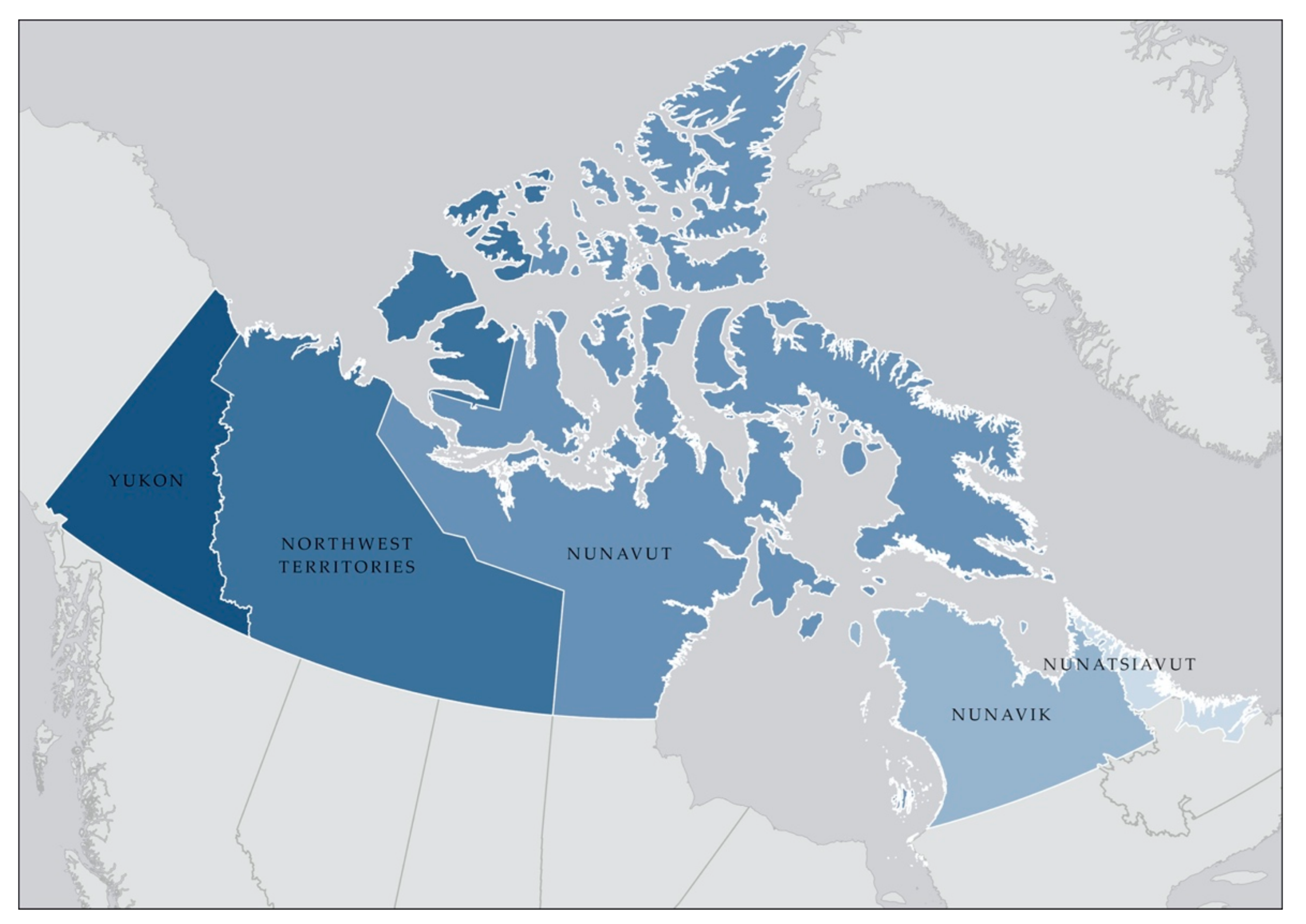
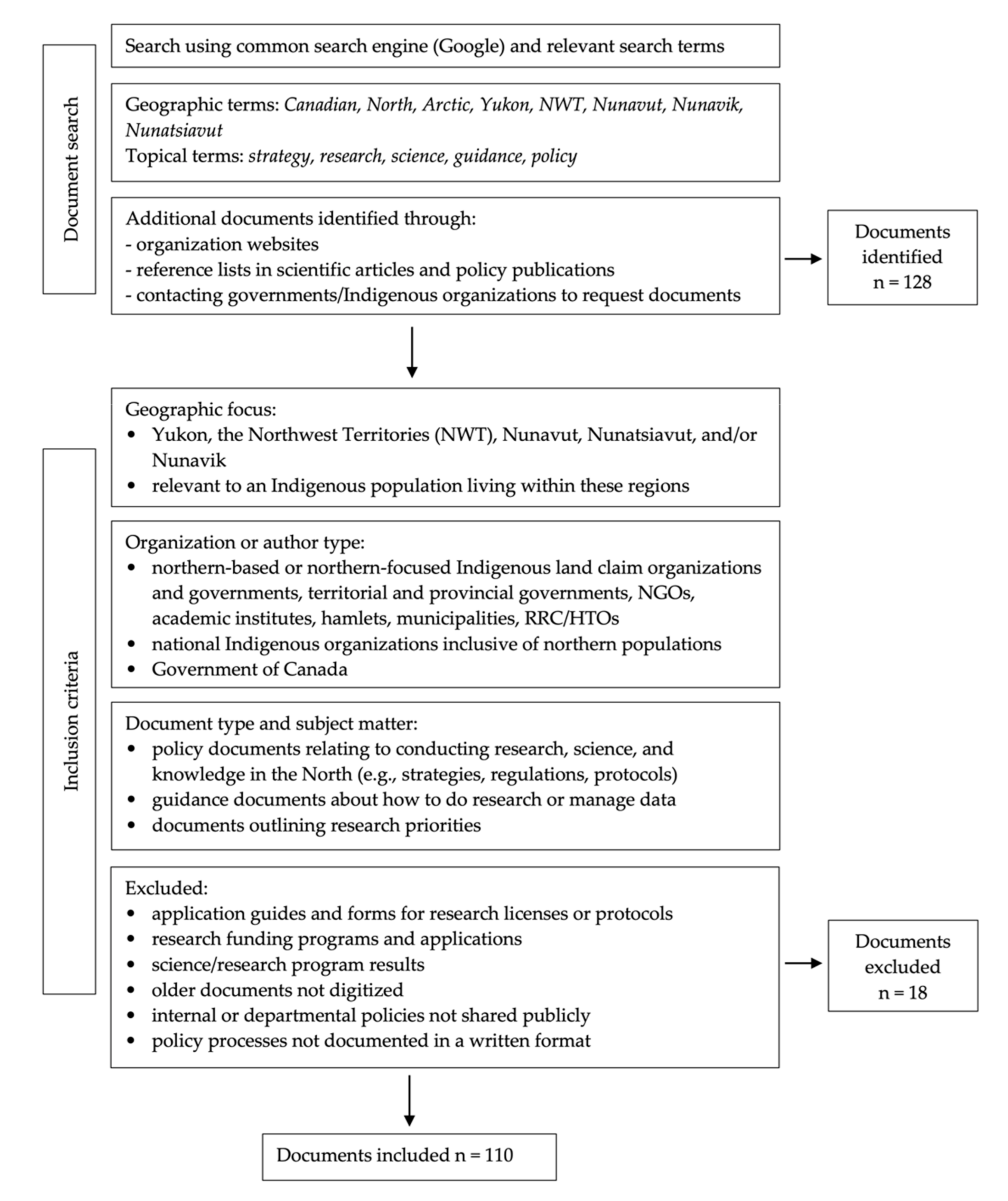
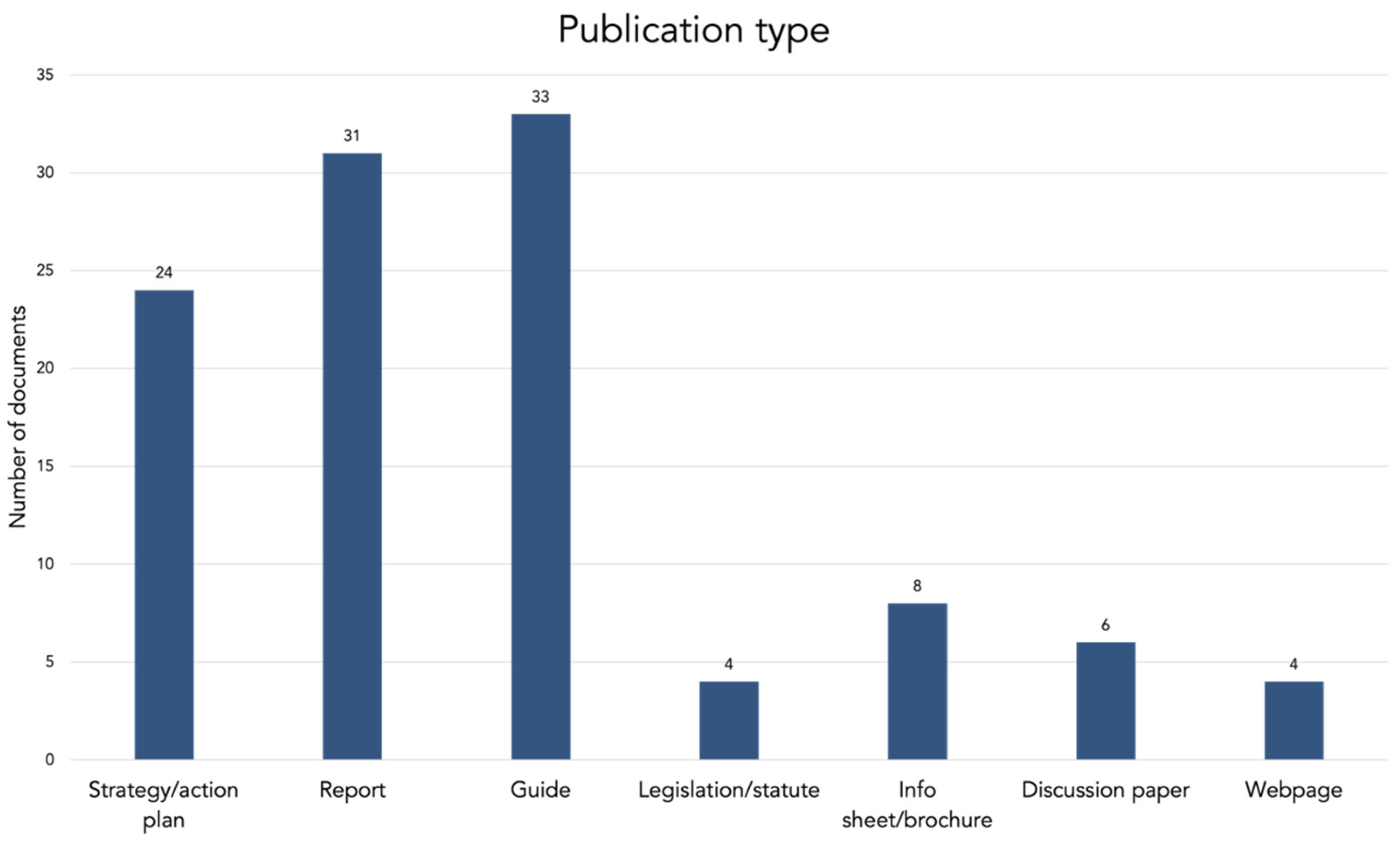
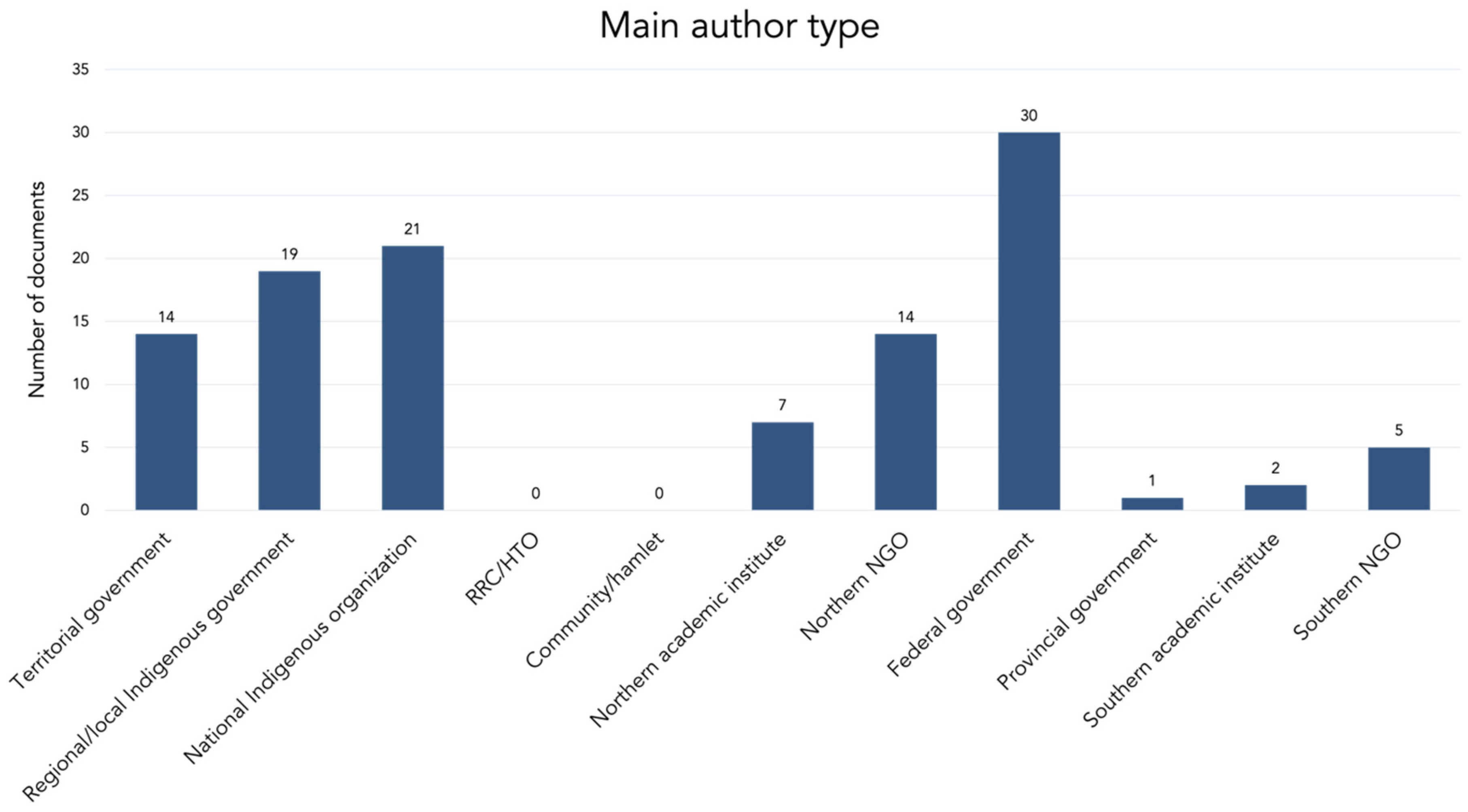

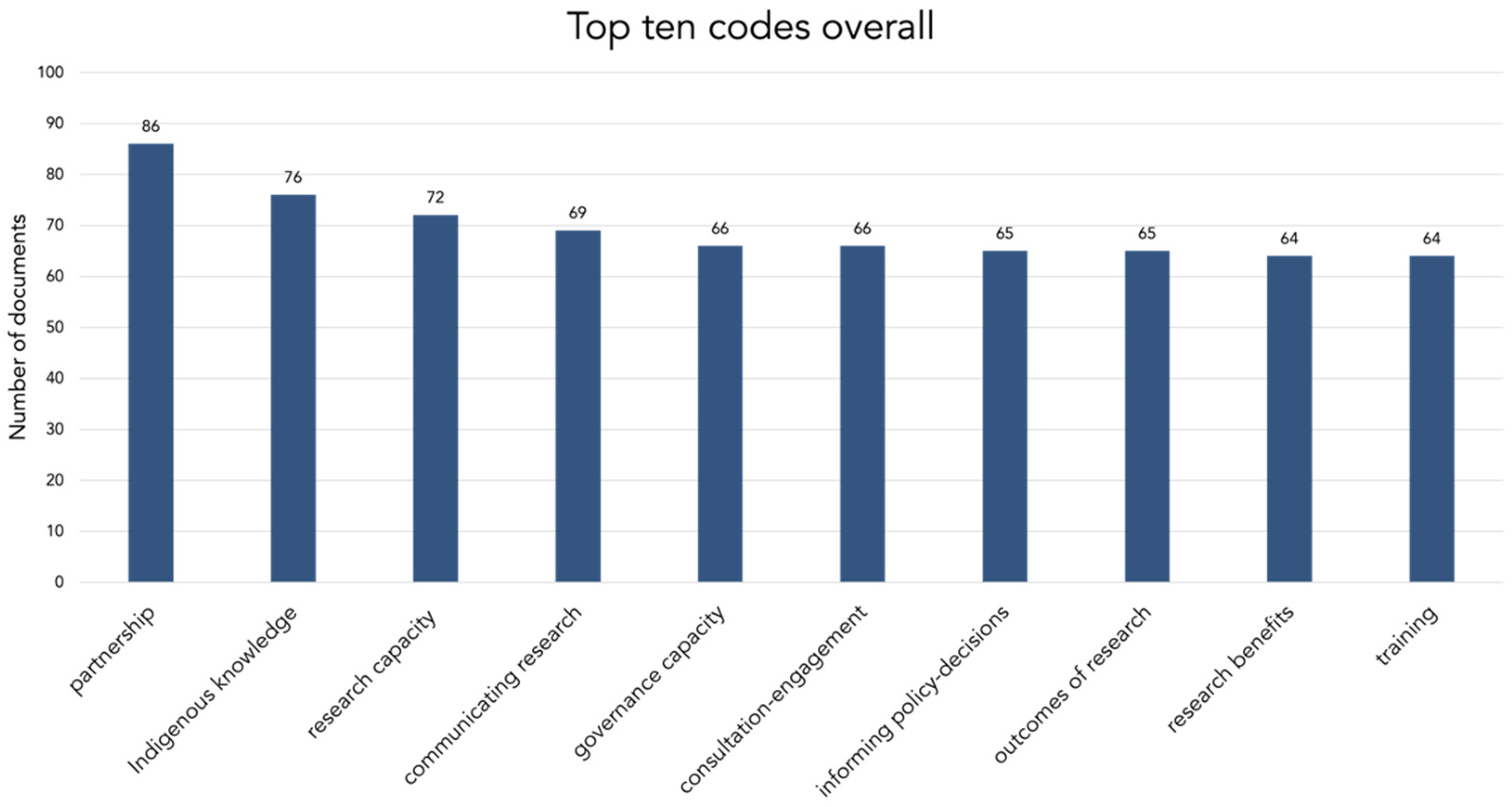
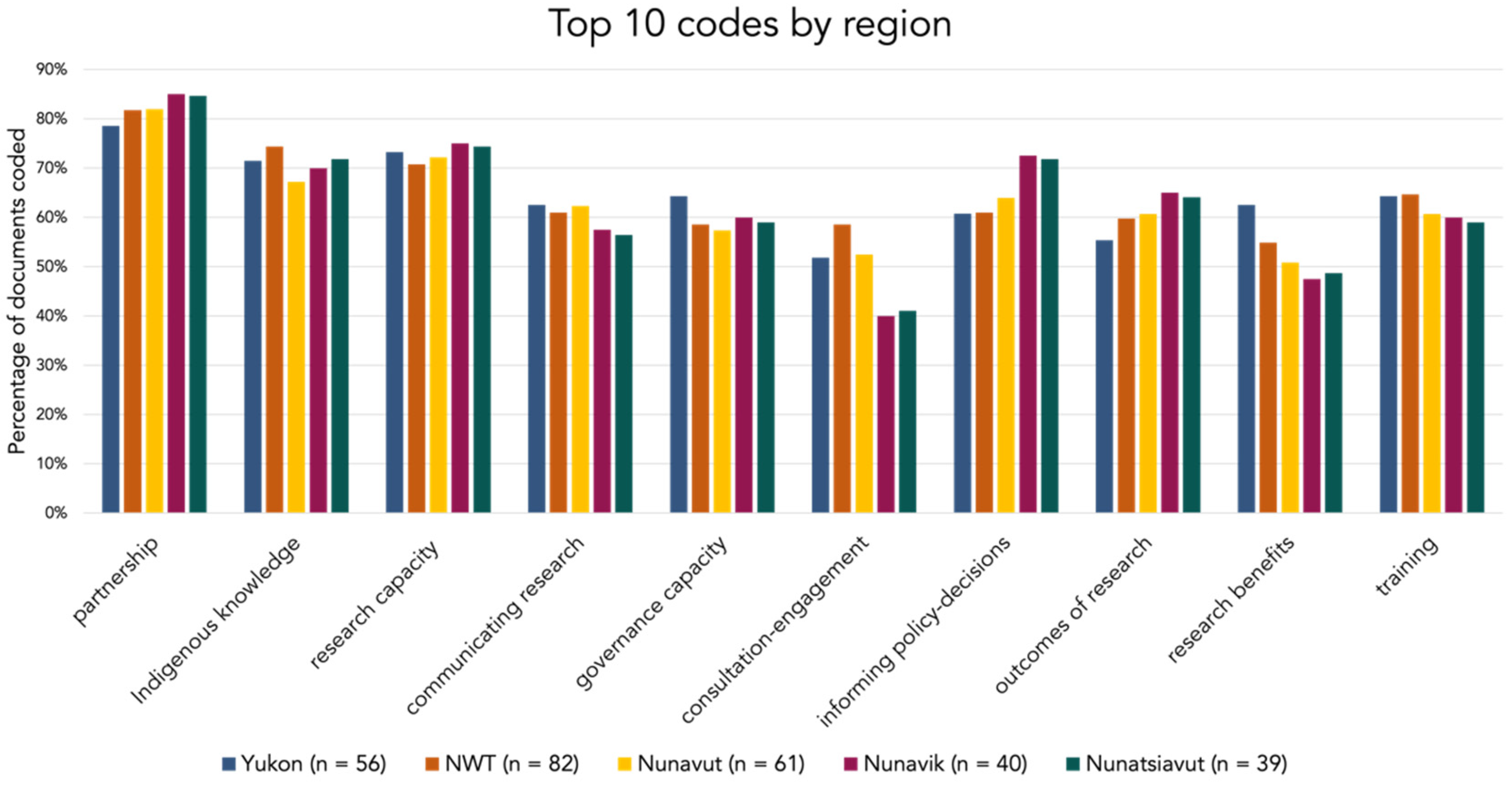

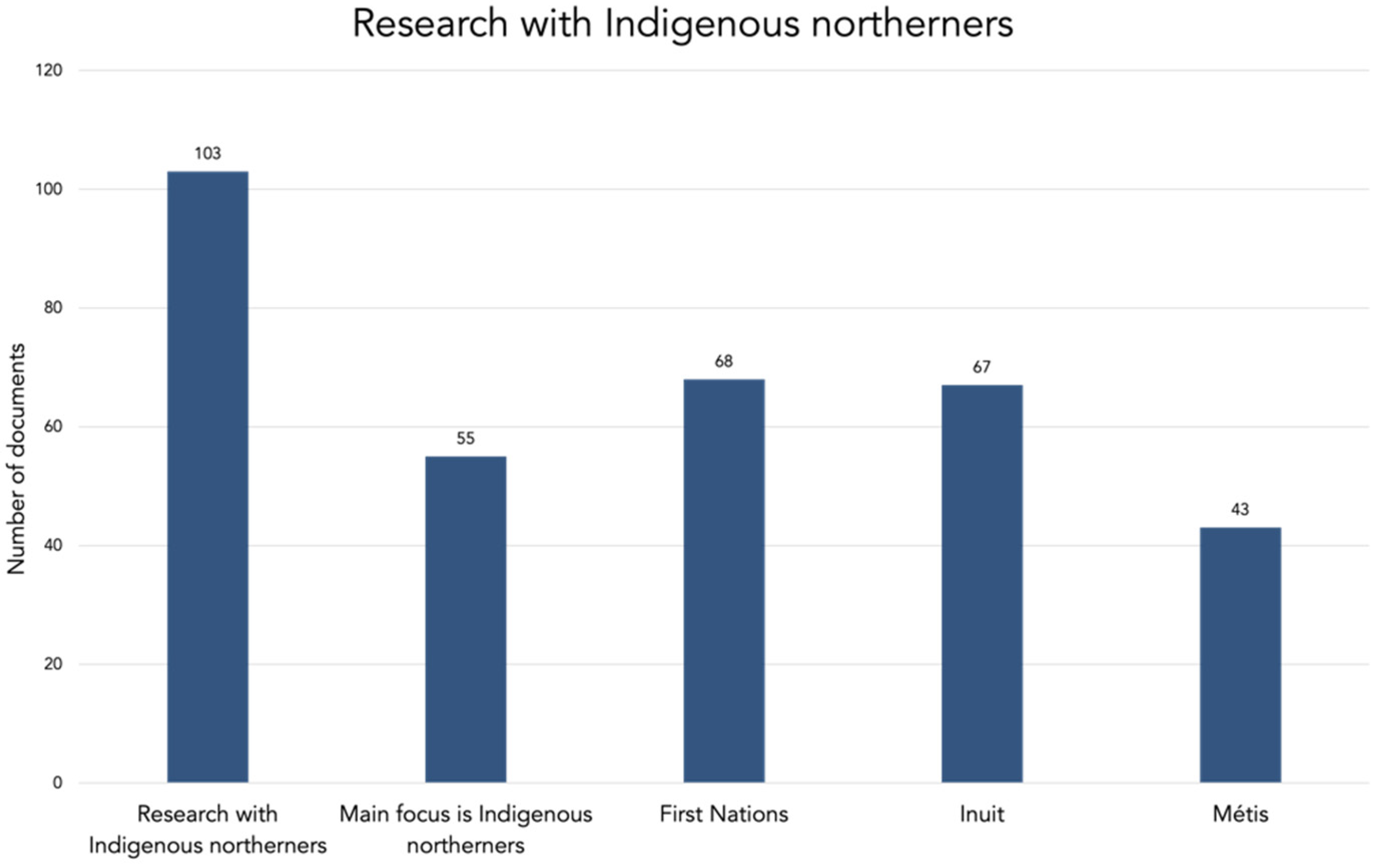

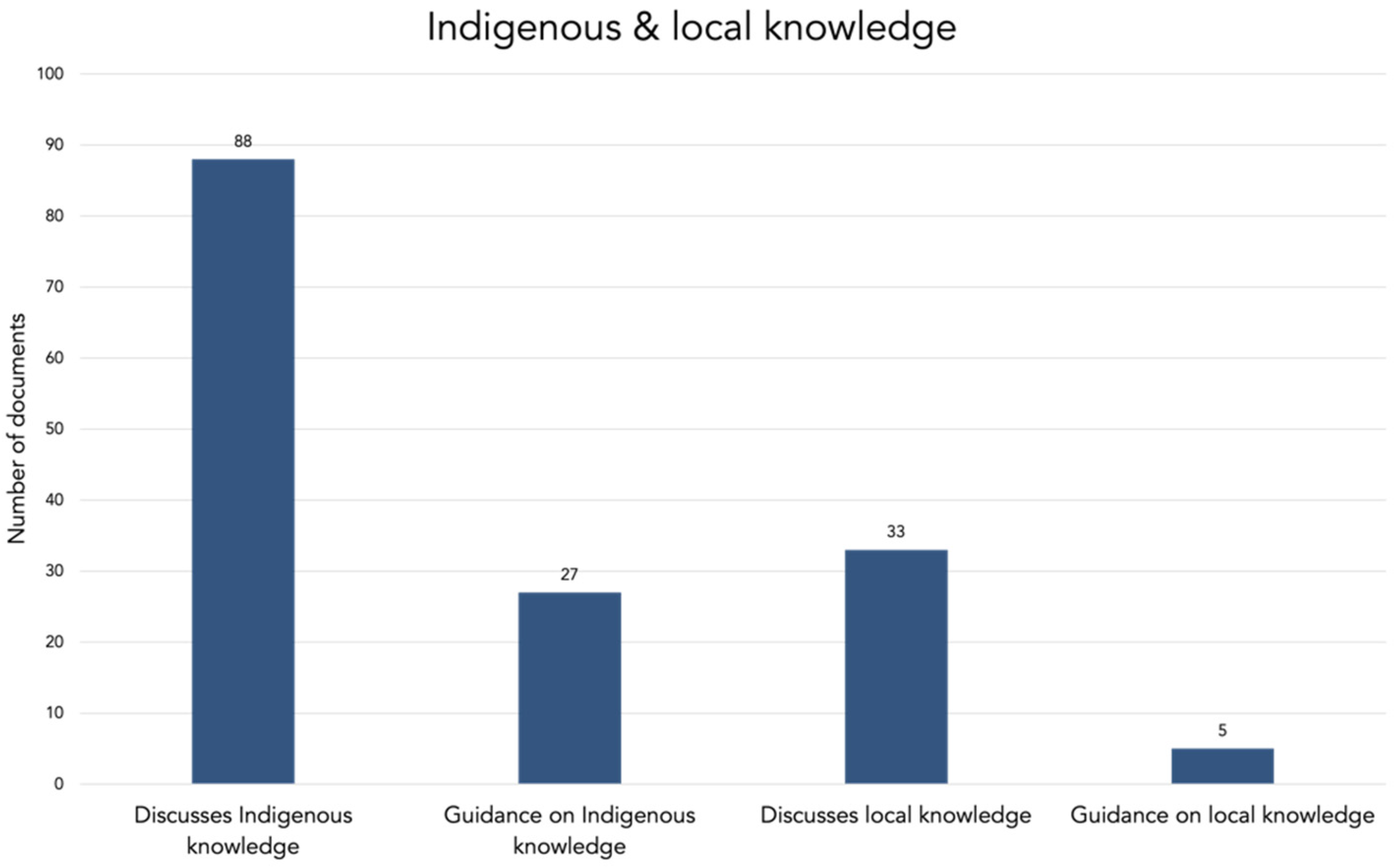
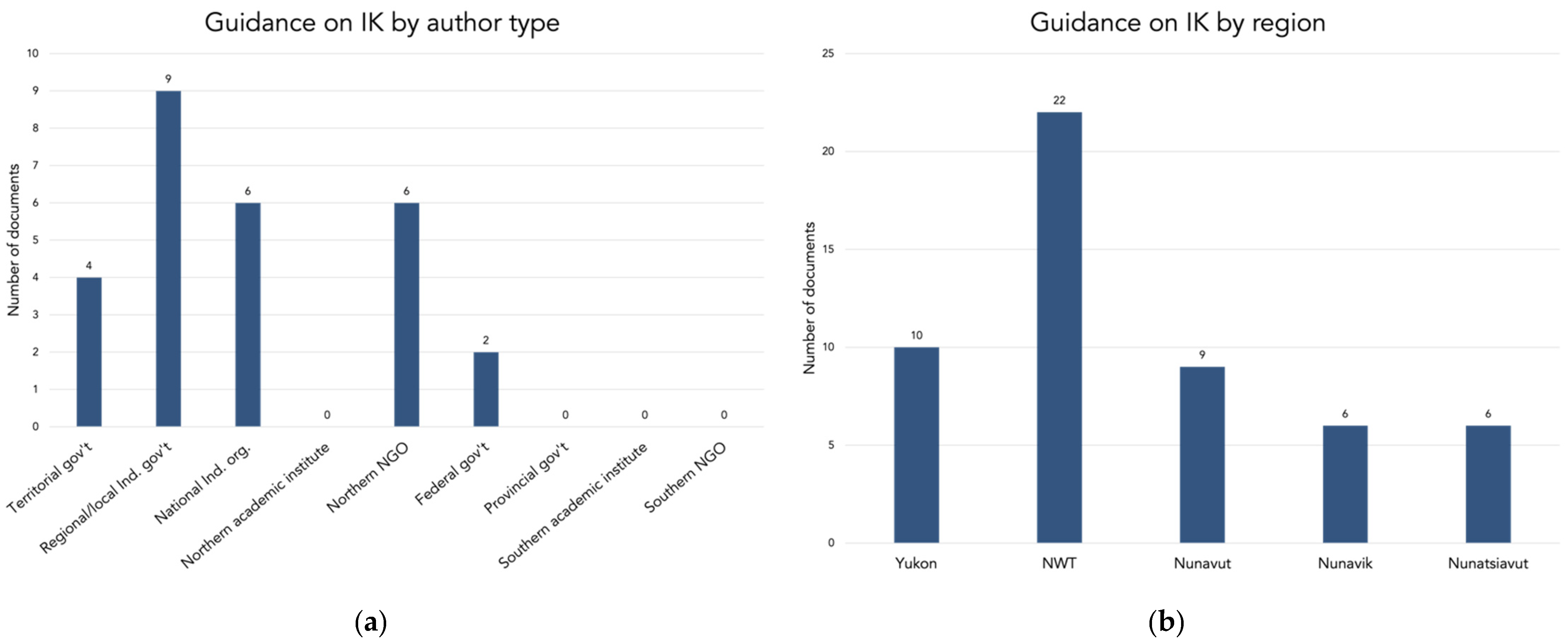
| Regional Scale | Number of Documents | Description |
|---|---|---|
| Pan-northern | 53 | Relevant to 2 or more regions |
| Regional | 43 | Relevant to a region (Yukon, NWT, Nunavut, Nunavik, or Nunatsiavut) |
| Sub-regional | 13 | Relevant to a subregion or traditional territory (e.g., ISR) |
| Community | 1 | Relevant to a single community |
Publisher’s Note: MDPI stays neutral with regard to jurisdictional claims in published maps and institutional affiliations. |
© 2021 by the authors. Licensee MDPI, Basel, Switzerland. This article is an open access article distributed under the terms and conditions of the Creative Commons Attribution (CC BY) license (https://creativecommons.org/licenses/by/4.0/).
Share and Cite
Perrin, A.D.; Ljubicic, G.; Ogden, A. Northern Research Policy Contributions to Canadian Arctic Sustainability. Sustainability 2021, 13, 12035. https://doi.org/10.3390/su132112035
Perrin AD, Ljubicic G, Ogden A. Northern Research Policy Contributions to Canadian Arctic Sustainability. Sustainability. 2021; 13(21):12035. https://doi.org/10.3390/su132112035
Chicago/Turabian StylePerrin, Alison D., Gita Ljubicic, and Aynslie Ogden. 2021. "Northern Research Policy Contributions to Canadian Arctic Sustainability" Sustainability 13, no. 21: 12035. https://doi.org/10.3390/su132112035
APA StylePerrin, A. D., Ljubicic, G., & Ogden, A. (2021). Northern Research Policy Contributions to Canadian Arctic Sustainability. Sustainability, 13(21), 12035. https://doi.org/10.3390/su132112035








